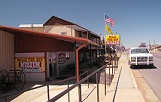The name of the monument comes from
the dry salt lakes on the plains to the east of Mountainair.
The area was home to two ancient
southwestern cultures, the Ancestral Puebloans and Mogollon, people with roots
going back 7,000 years and beyond that to nomadic Indians as early 20,000 years
ago.
Abó, Quarai and Gran Quivira were
located along major trade routes between Rio Grande villages and plains tribes
to the east. They traded, salt, maize,
beans, squash, pinion nuts and cotton for dried buffalo meat, hides, flints and
shells.
In 1598 the Spanish arrived bringing
with them, horses, cattle, goats, fruit trees, wheat and metal.
Franciscan missionaries came with
the soldiers, converting local tribes and building churches, citizens appointed
by the governor were supposed to provide aid, protection and education but the
system was abused and the area too remote for anyone to check up on what was
really happening.
Eventually years of drought,
wide-spread famine and a population decimated by European diseases to which
they had little resistance led to the abandonment of the pueblos and missions
during the 1670’s.
Gran Quavira, 25 miles south of
Mountainair on highway 55, the largest of the missions is also where the most
excavation has taken place, although the ranger at the park headquarters in
Mountainair did tell us that there are plans to backfill the excavated pueblos
in order to preserve them. Unlike Quarai
and Abó, Gran Quavira is built of limestone.
At Quarai, about 9 miles north of
Mountainair, the soaring walls of the red sandstone church stand high above the
mostly unexcavated mounds of the surrounding pueblo.
At Abó just of highway 60 is a stone arroyo and spring where both the pueblo and the church obtained most of their water, apart from one pool of standing water, both were dry when we visited.
The historic Shaffer Hotel in
Mountainair, we had a lovely late lunch in the dining room.
The Salinas Pueblo Missions National
Monument visitor centre, the sky really did look like that.
The monuments spiral out from
Mountainair and although it’s a lot of driving, they are very interesting and
well worth visiting.
Have fun, we are!


















































